Breastfeeding is like dancing. If you are going to learn to dance you need to know where to put your body and then how to move your feet. It may feel awkward at first. It might come easily or it may be difficult. But with practice nursing your baby can become second nature. The first thing to think about when breastfeeding or chestfeeding is how you are going to position your body and your baby’s body. Once you are in a good position, it will be easier for your baby to latch.
Good positioning and latching is important for building and maintaining your milk supply. When your baby latches deeply onto your breast, your baby is able to remove milk effectively. When your breasts are well-drained, your body gets the message to make more milk. If you are concerned about how much milk you are making, improving positioning and latching is an important first step.
For information on your baby’s very first feeding immediately after birth, please see The First Hours After Birth and Establishing Your Milk Supply.
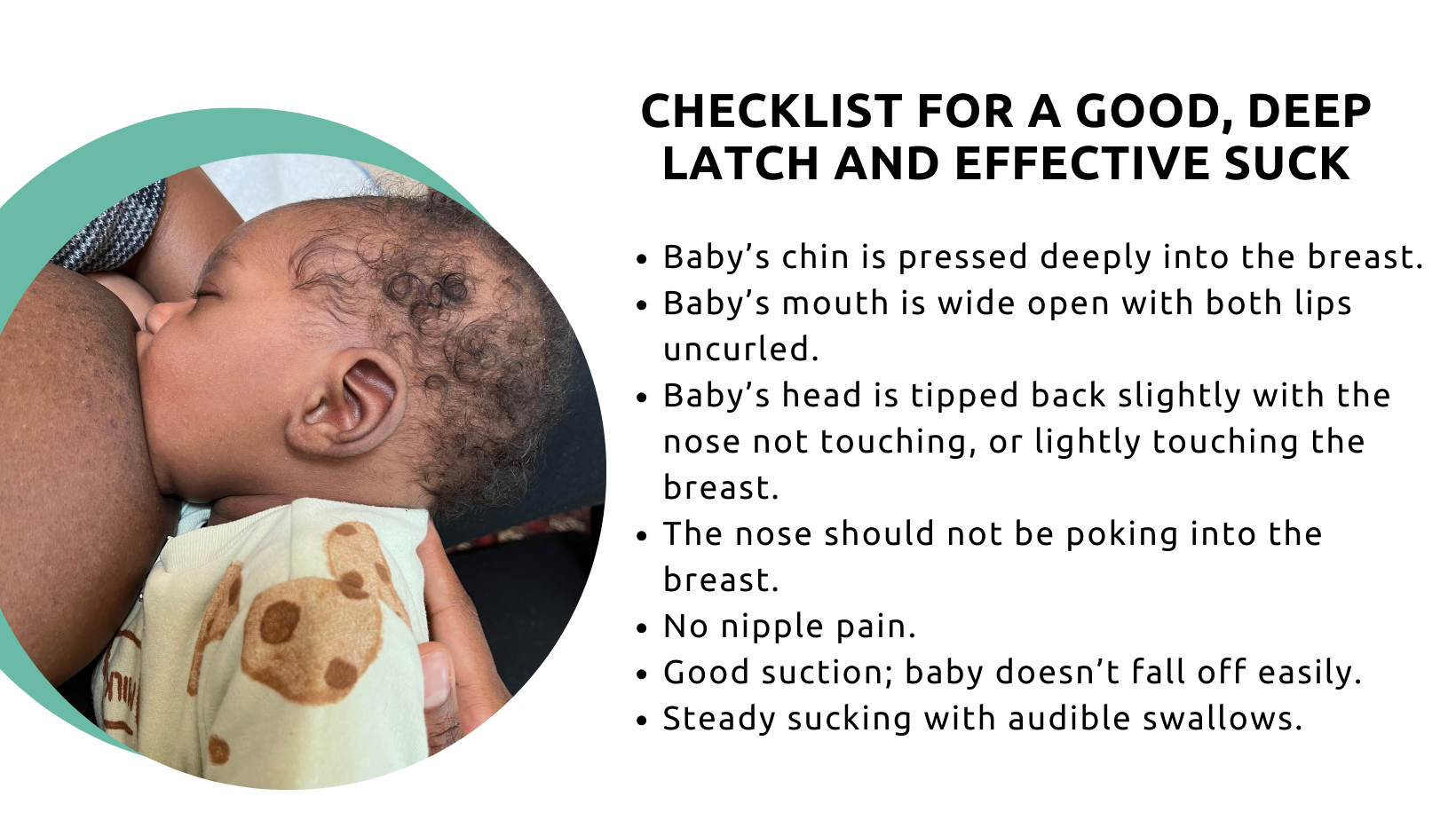
Before You Begin: Setting The Stage For Success
Start with a calm baby. This can be tricky sometimes. If your baby is hungry or has just woken up, she may get upset very quickly. Watch for signs that your baby is hungry. Offer your breast before she starts to cry.
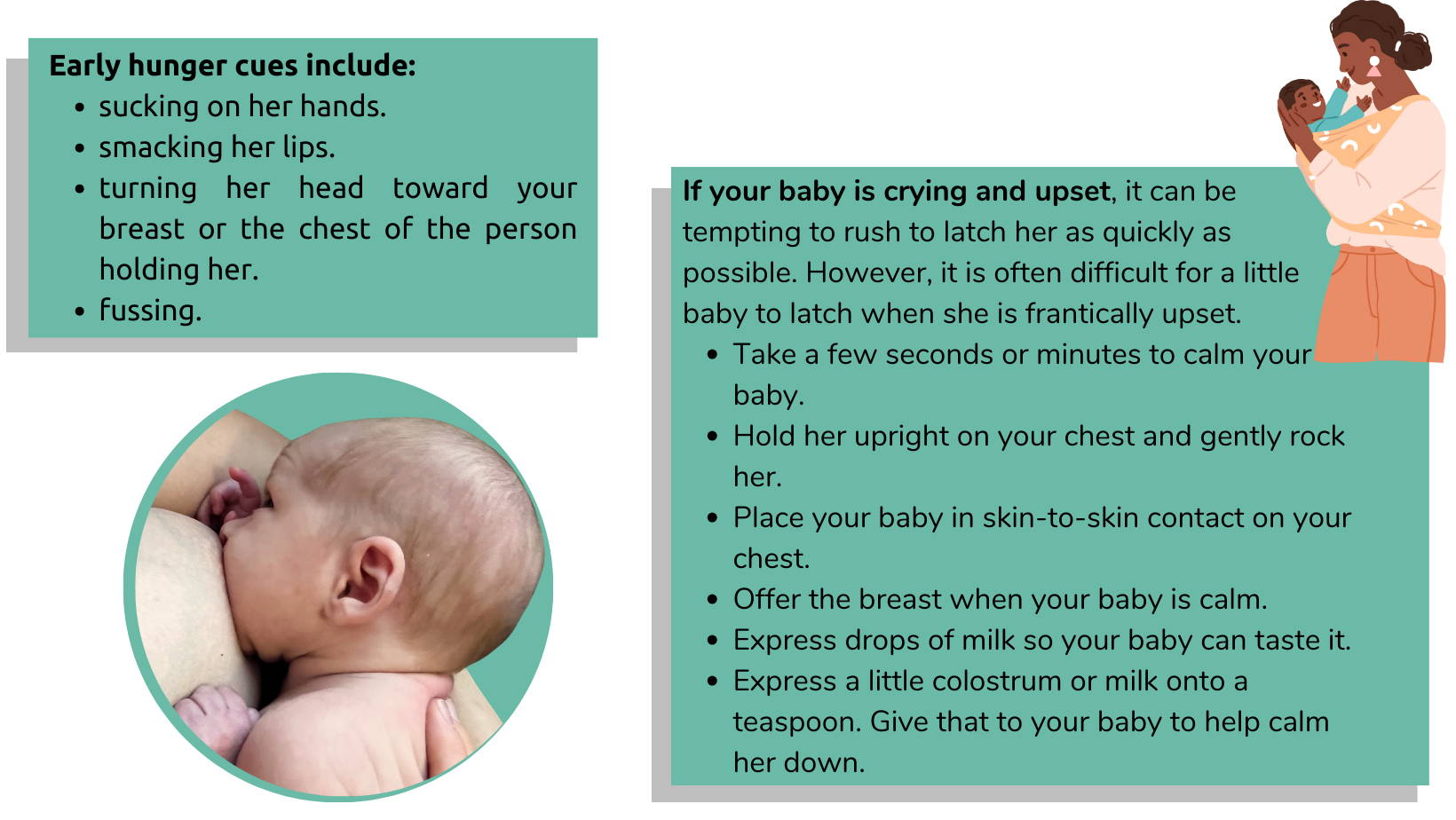
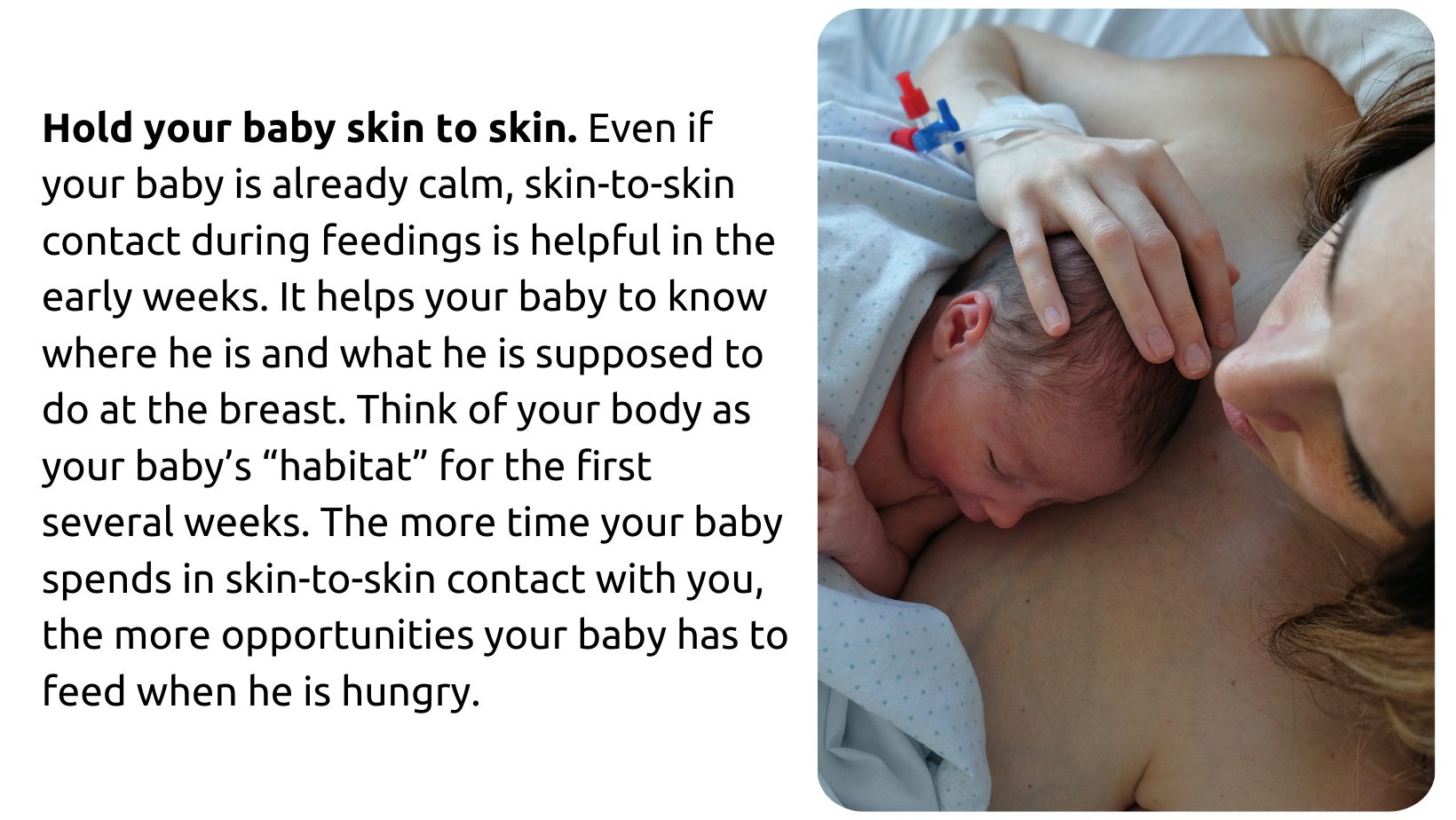
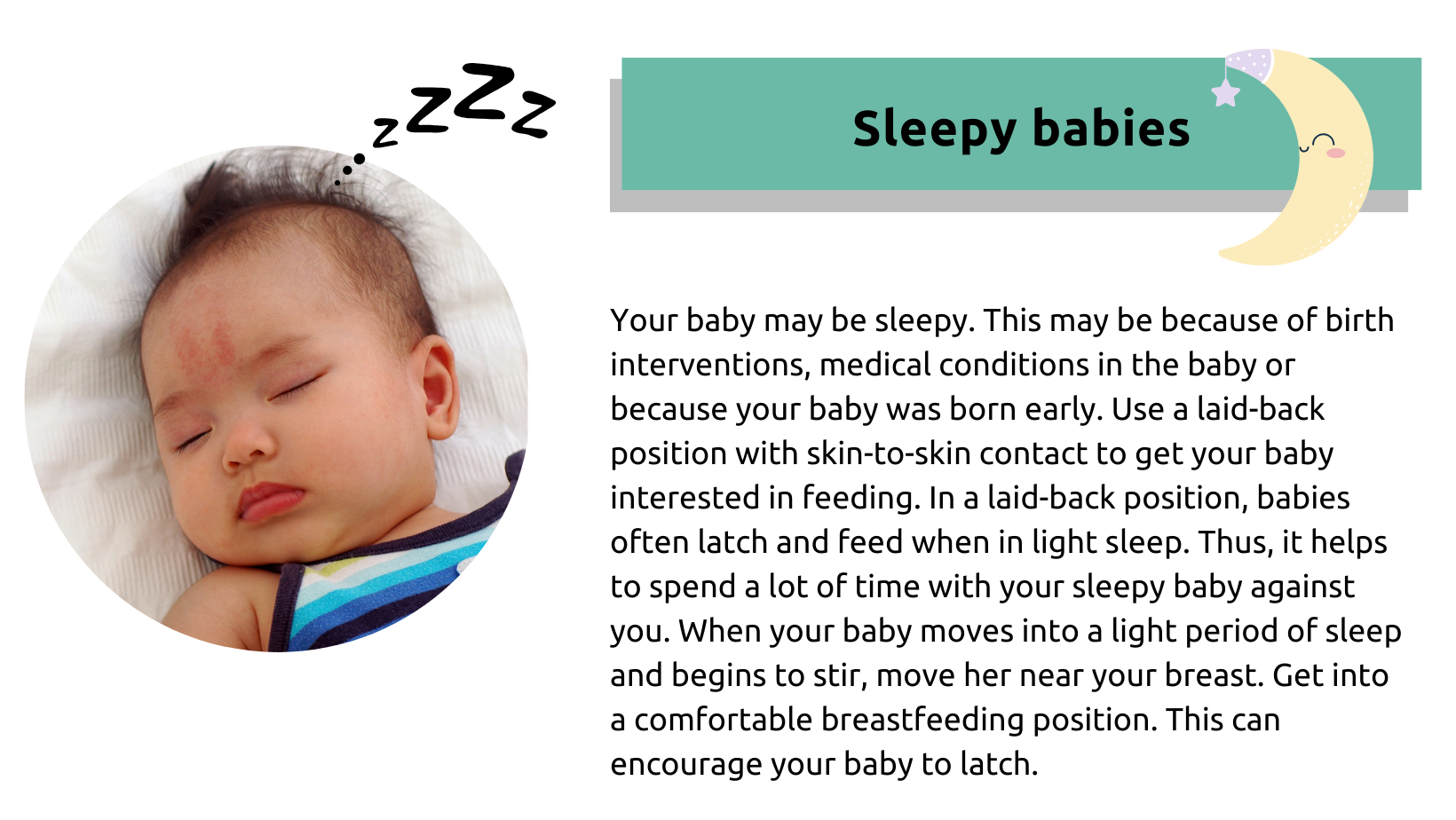
Getting into Position
There are many different breastfeeding positions. Some can be more helpful than others in the early stages when you and your baby are learning to breastfeed. These positions include: the cradle hold, the cross-cradle hold, the football hold, side-lying position, and more. One of the best positions for the early days and weeks (and longer!) is called the laid-back position.
The laid-back breastfeeding position is a helpful first place to start if:
- you are having difficulty getting a comfortable latch.
- your baby seems stressed while nursing.
- your baby’s arms are getting in the way.
- you can’t get into a comfortable position.
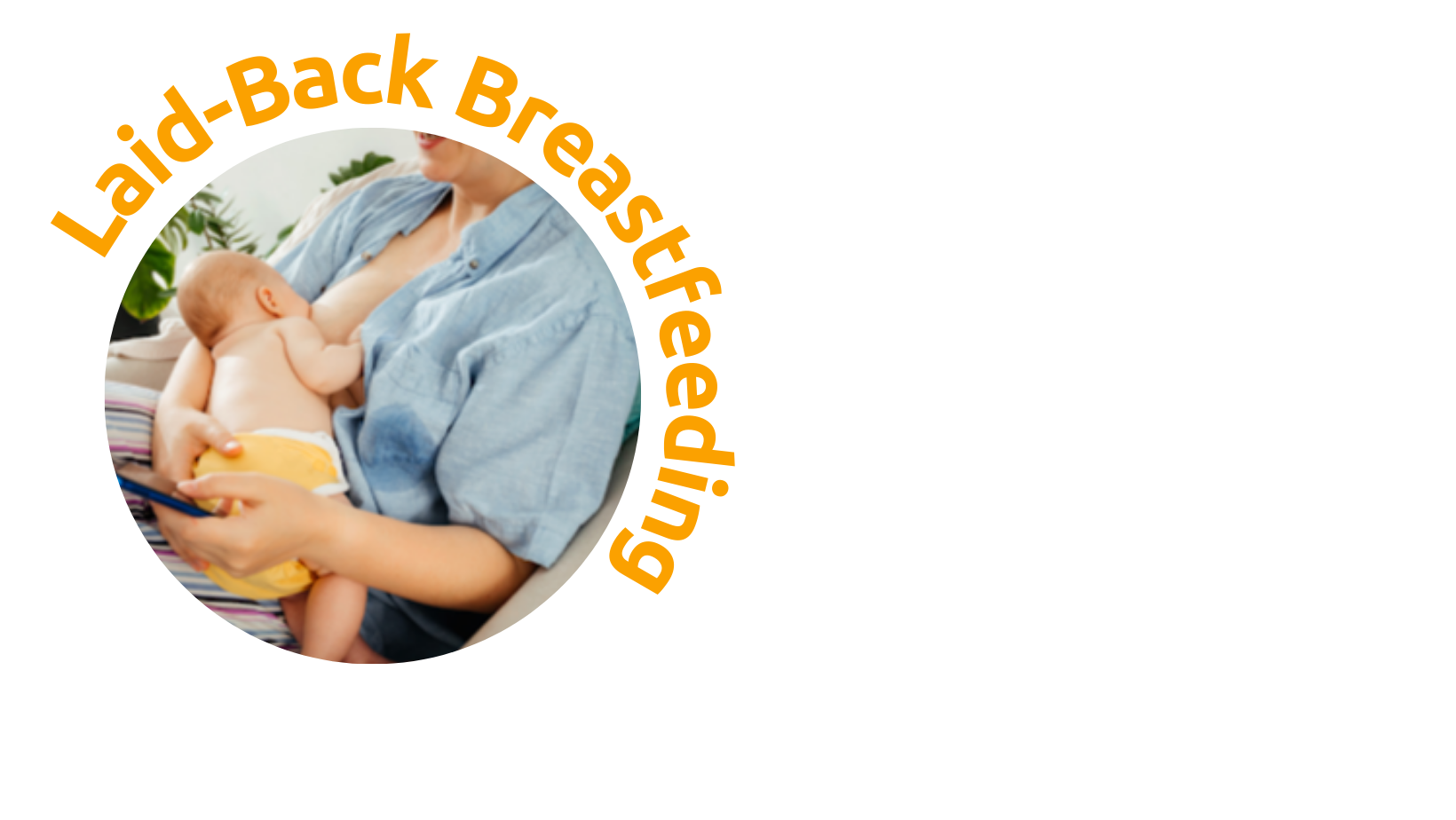
Get comfortable. Even little babies get heavy when you are holding them at the breast for hours each day.
- Find a bed or couch where you can lean back and be well supported. Lean back comfortably, like you might be if you were watching television. Laying flat on your back is not helpful for this position.
- Use a footstool to prop up your feet. It helps to raise your lap and take pressure off of your stomach muscles. Or better yet, put your feet up on the couch or bed with a pillow under your knees.
- Have some pillows nearby. Once your baby is comfortably latched, you can tuck pillows under your arms or elbows. Supporting your arms allows your shoulders and neck to relax.
- Support your head. You can use a pillow or the back of the couch.
Ensure full body contact.
If your baby feels completely secure, he will be able to focus on feeding. If he feels insecure, he may wave his arms around or kick his feet in an attempt to hang on to you.
- The laid-back breastfeeding position uses gravity to hold your baby close.
- This position molds his body to your body. It allows your baby to feel safe and secure, knowing that he is not going to fall.
- It is important that the whole front of your baby’s body has full contact with the front of your body. This means that your baby’s chin, tummy, and legs should be in contact with your body.
- Your baby can rest on you in any direction you both like, as long as his front is next to your front. Your baby could lie with his feet down towards either one of your thighs. Or he could be across your body with his feet under your other breast.
- Most babies do not like their feet dangling. It is helpful to provide your baby with somewhere to plant his feet. For example, your baby’s feet could rest on your belly, legs or a pillow.
- When you are in position, your baby’s cheek should rest somewhere near your bare breast.
Adjust your breast as needed.
It is important for you to have your breast in a place that allows you to rest comfortably while feeding. The following may be helpful:
- Use your upper arm to secure your breast so the nipple does not fall to the side of your body.
- Hold your breast while your baby latches.
- Release your breast once your baby has latched deeply and started sucking. You may need to move a little to get into a more comfortable position.
- Bring your baby to your breast rather than moving your breast to your baby.
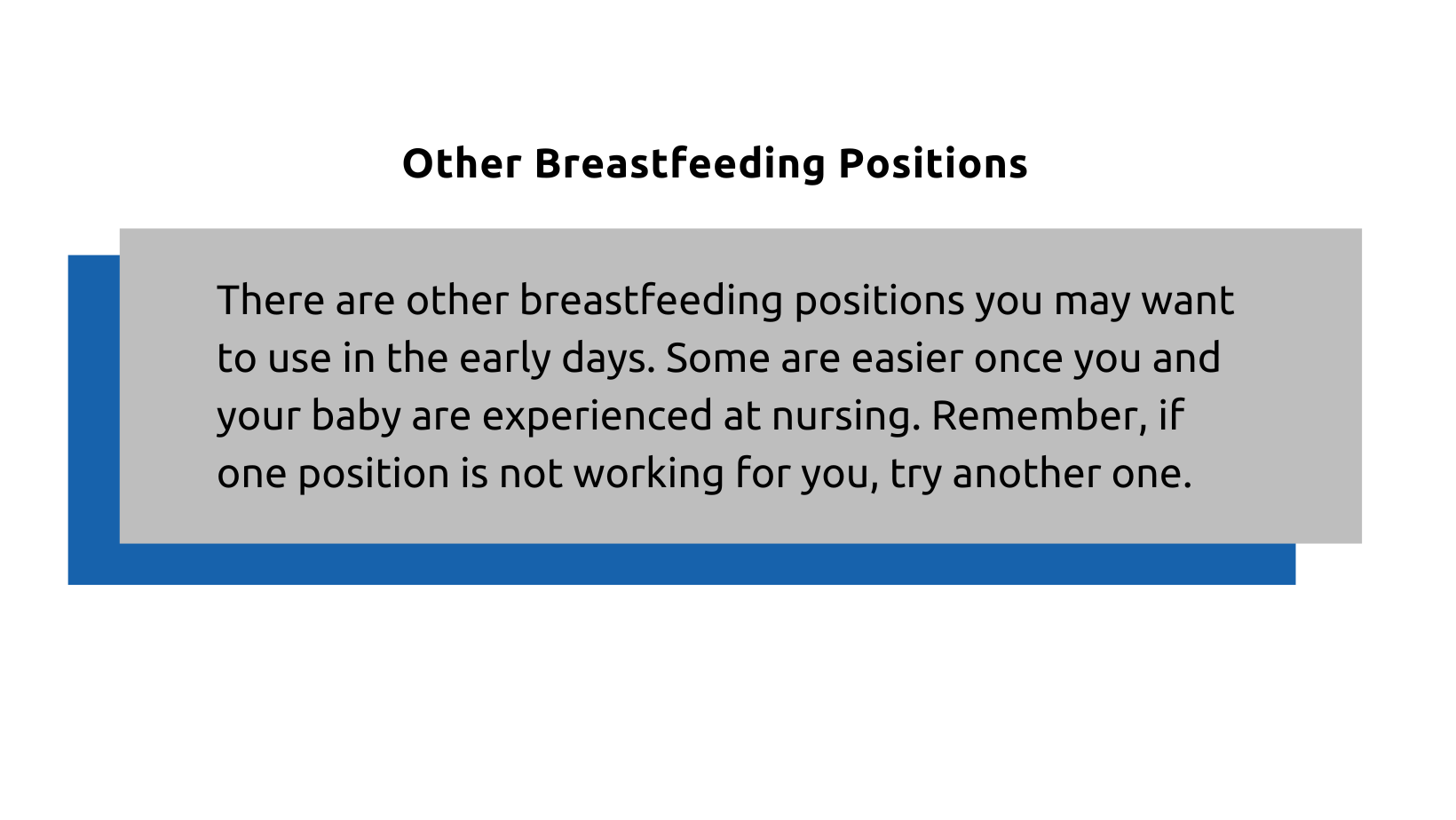
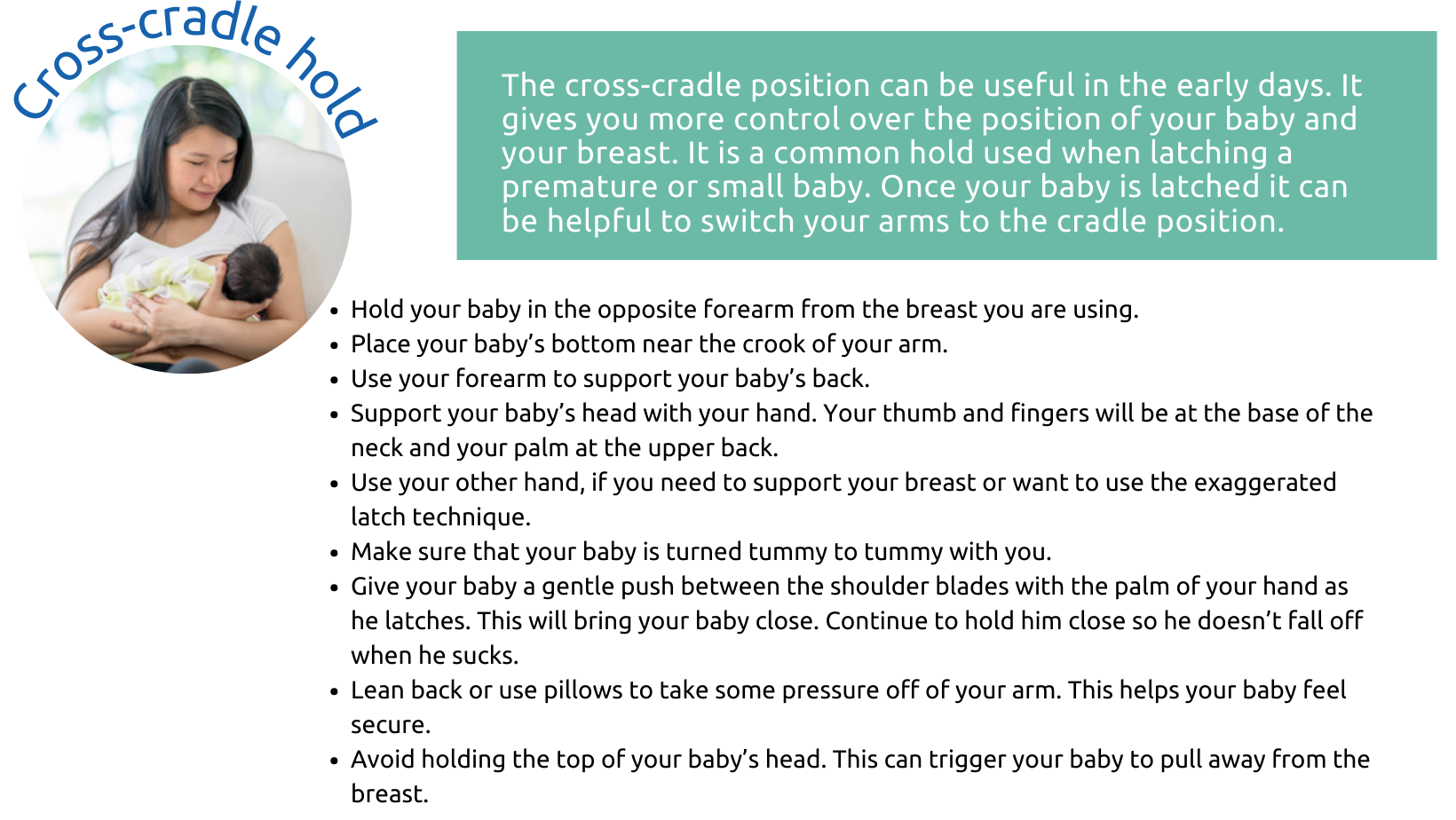
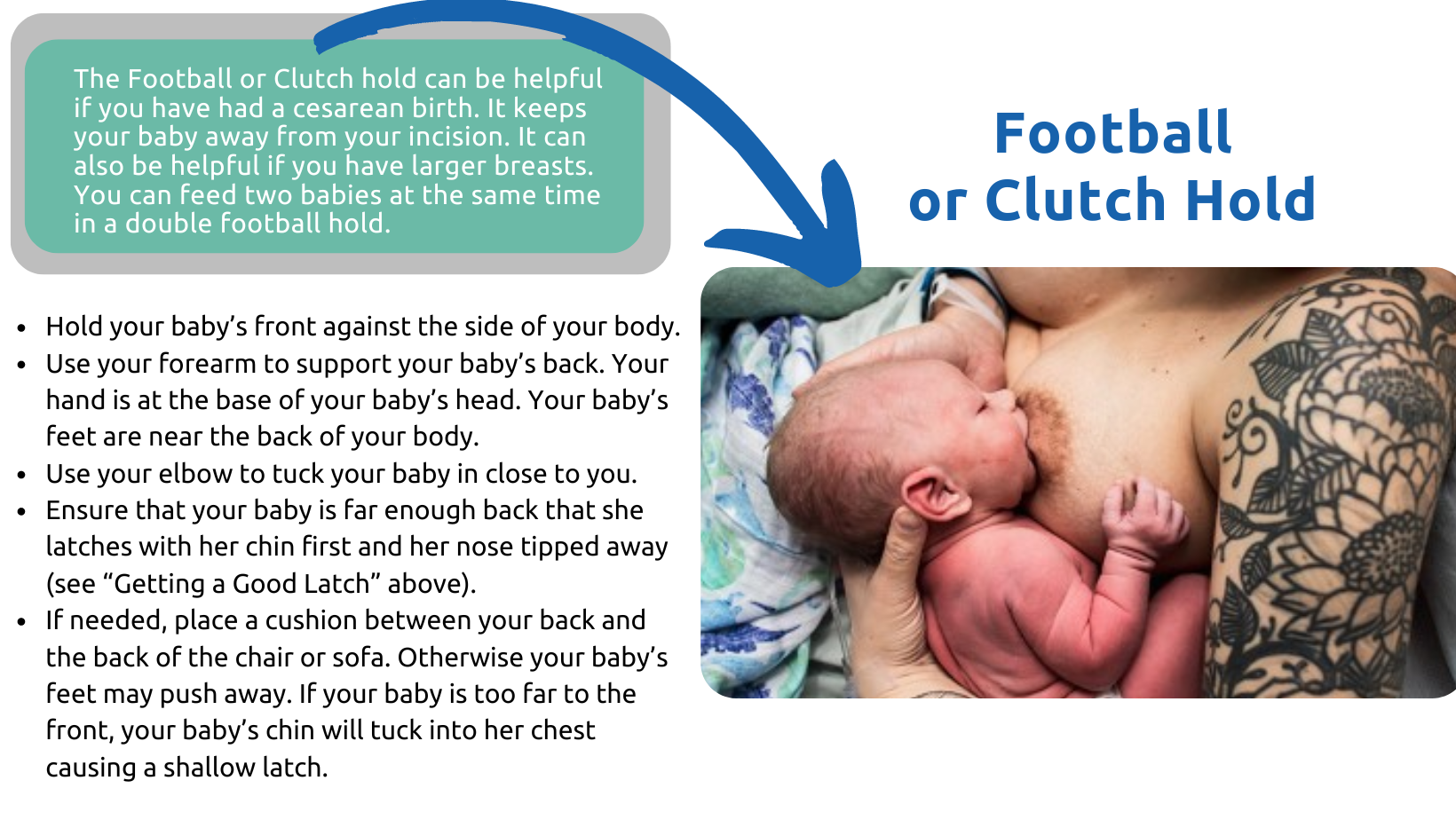
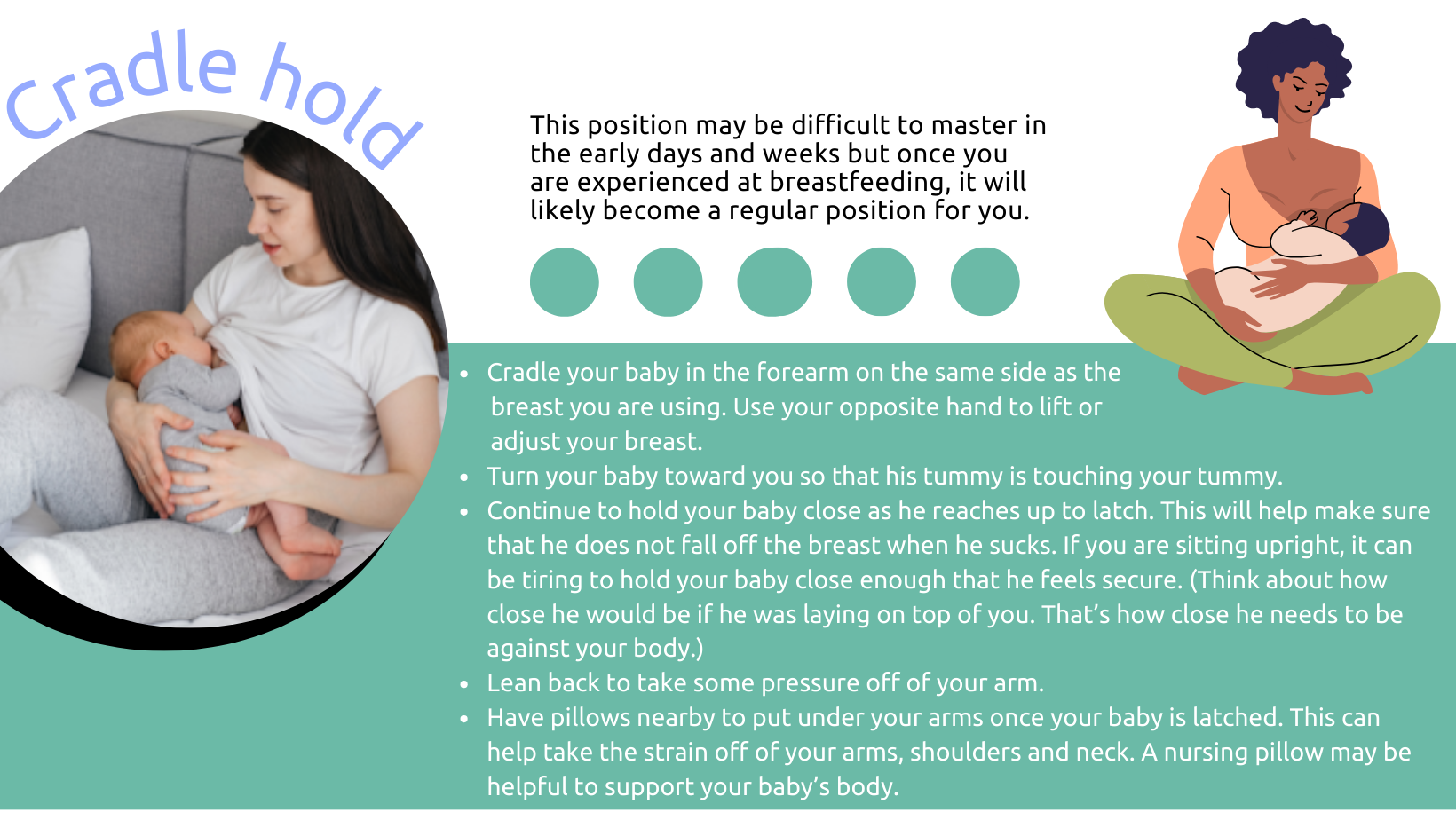
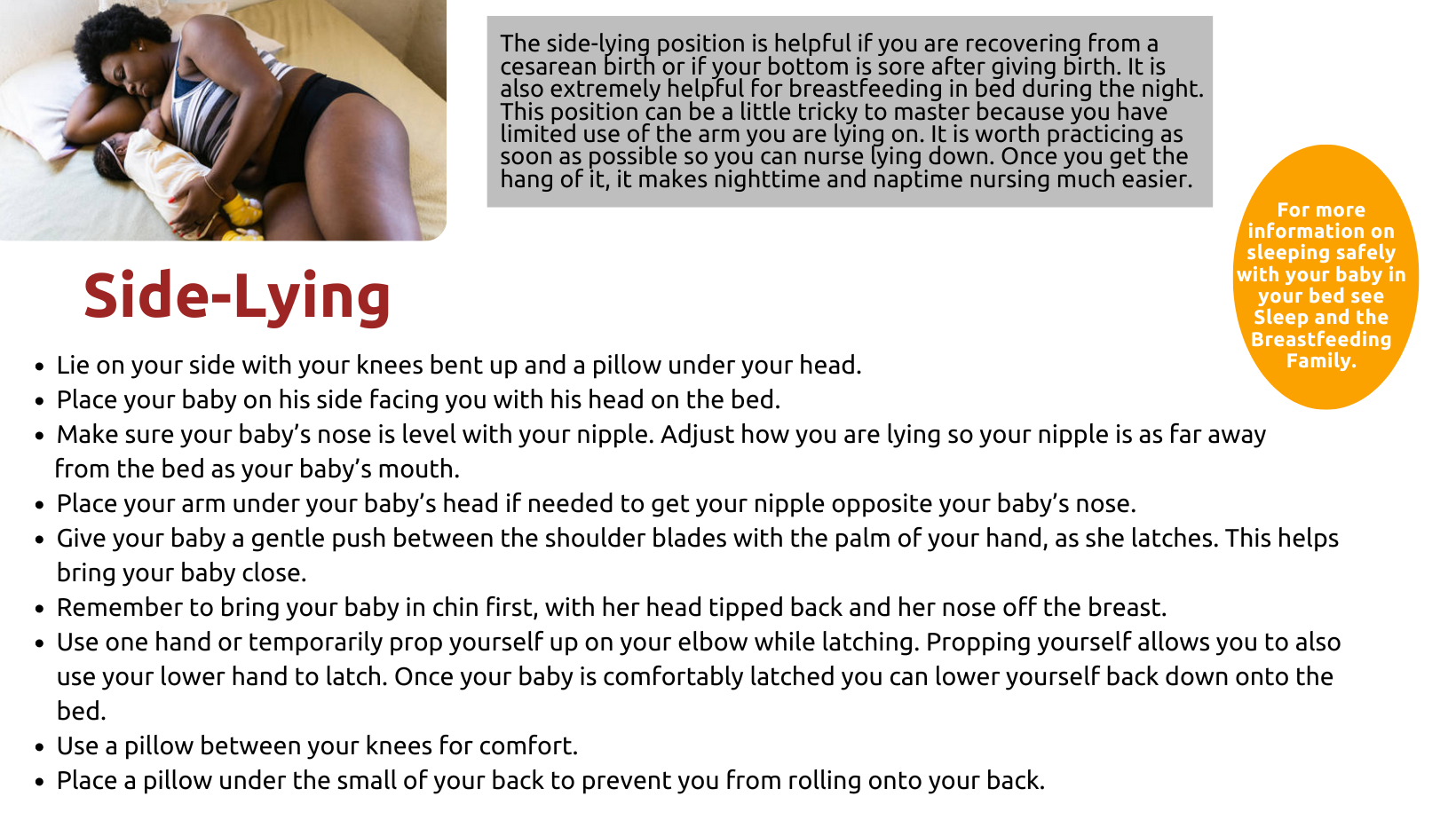
Getting a good latch
A comfortable, secure position allows your baby to use her instincts to latch deeply onto the breast. With a good latch your baby takes in a large mouthful of breast tissue. This gently stretches your nipple to the back of her mouth. When this happens, your baby is able to effectively remove the milk. A deep latch ensures that your baby gets plenty of milk and your body gets the message to keep making more. It also prevents pain and damage to your nipples.
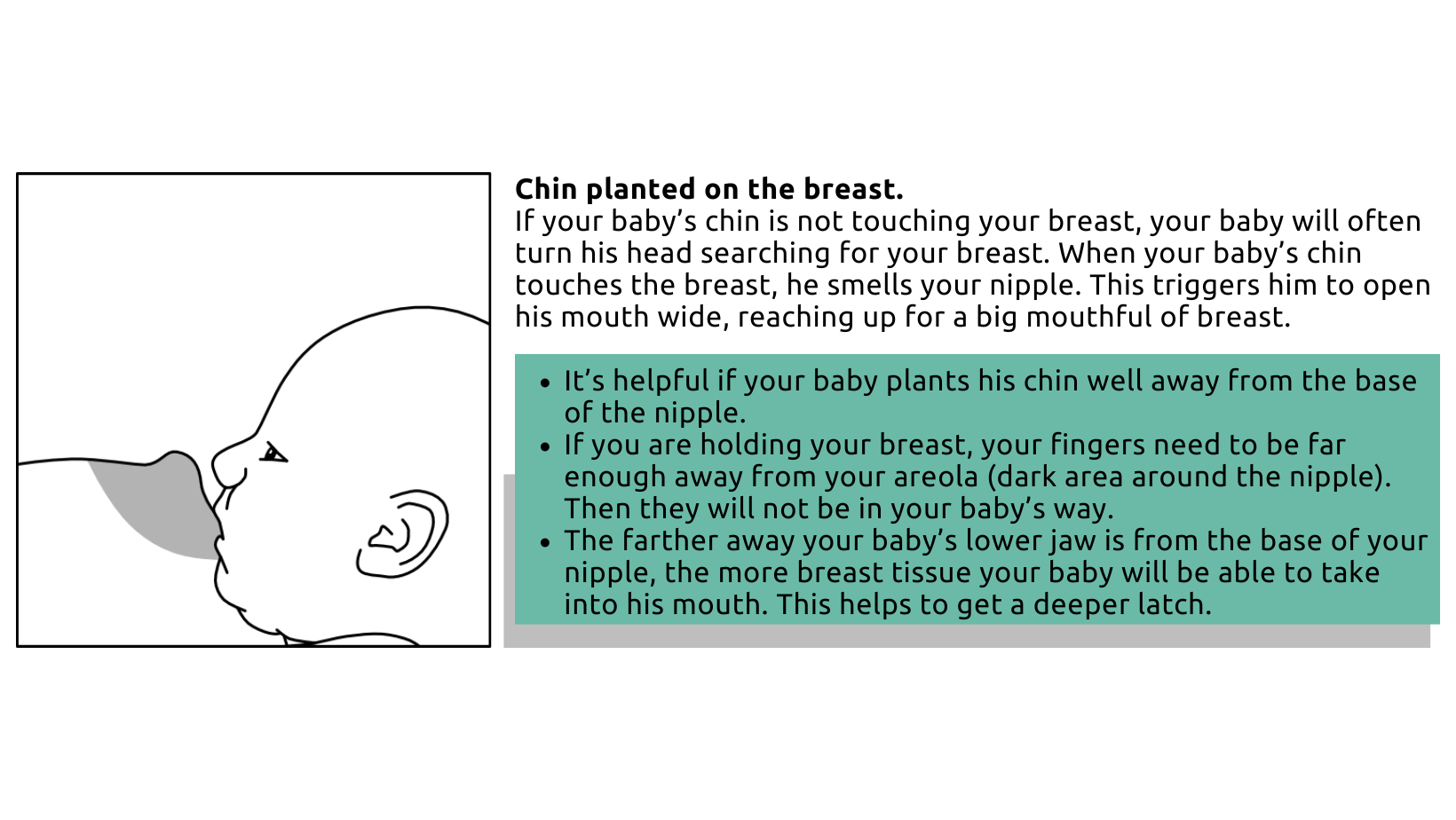
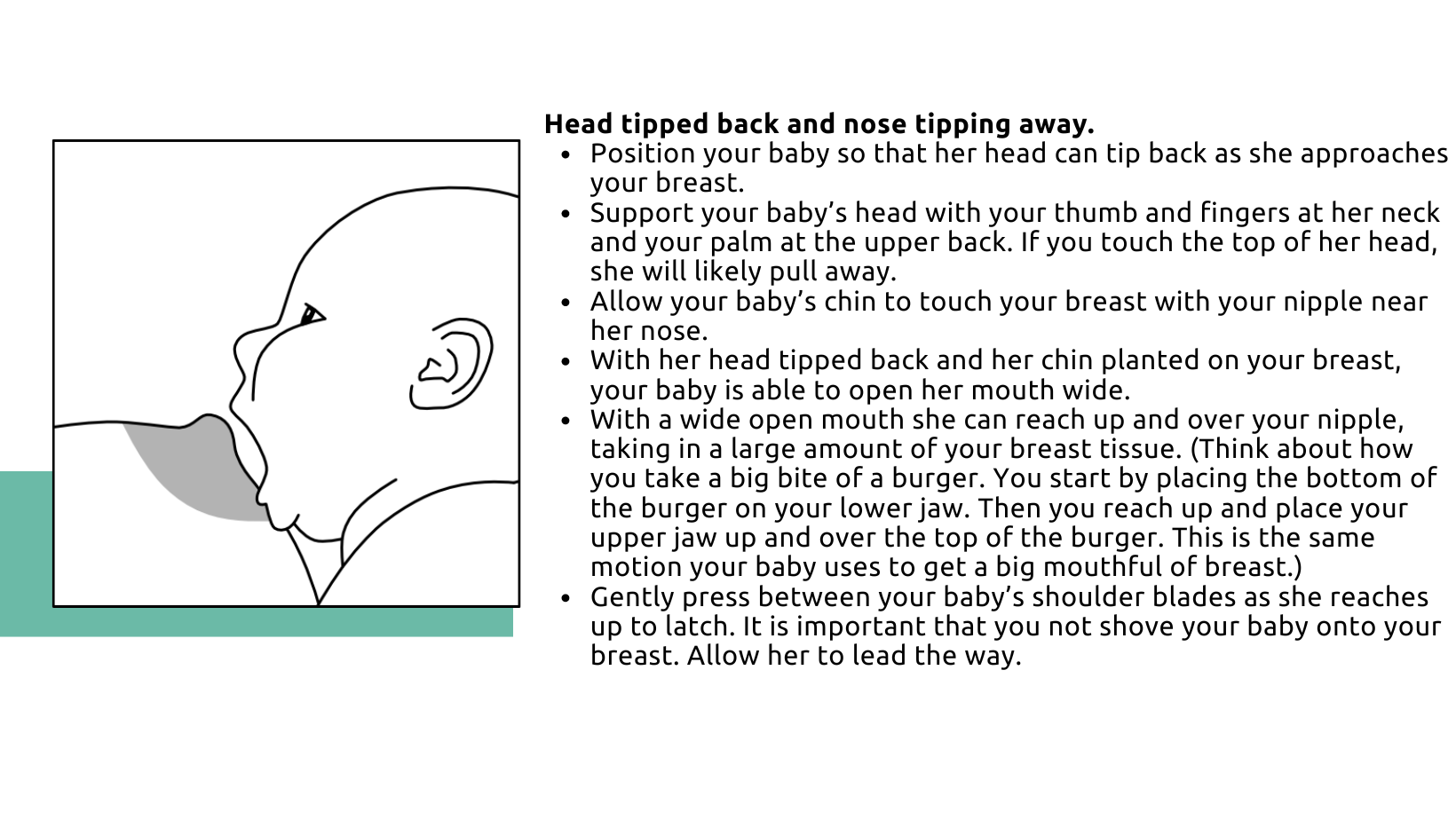
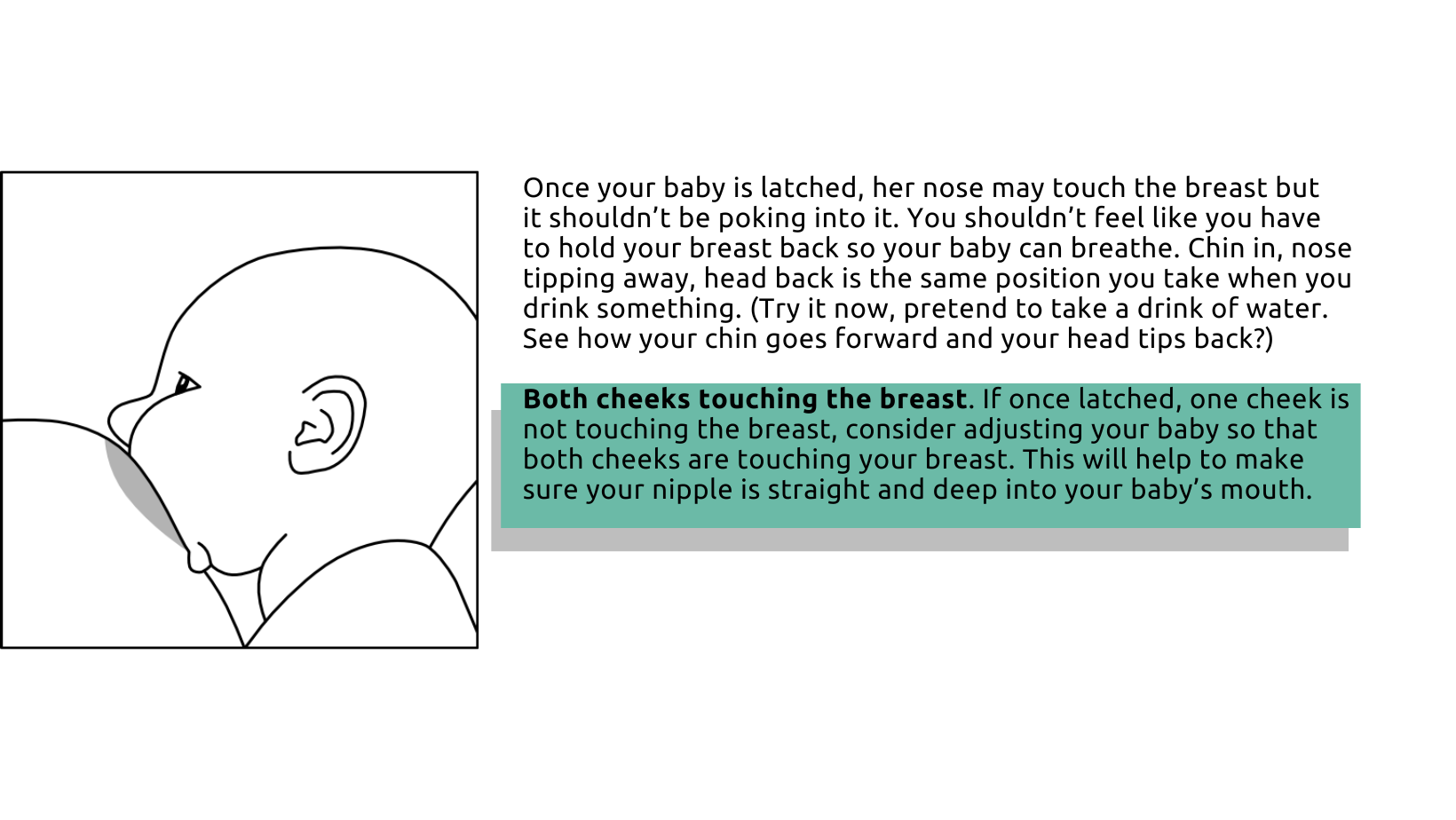
Adjust your baby as needed.
Babies often creep upwards or forwards while feeding.
- If your baby’s chin is tucked into his chest, he will not be able to hold onto the breast with his mouth. He will also find it hard to swallow. (Try it now. Tuck your chin into your chest and swallow. It is very difficult.)
- You may need to occasionally adjust your baby during feedings by sliding him downwards or backwards towards his feet.
- You may also need to pull your baby in gently from behind the shoulder blades. This will push your baby’s chin forwards, deeper into your breast. And it will tip your baby’s head back. In this position your baby can drink comfortably, just like you do.
The Nipple Tilt Technique
To get an even deeper latch, you can try using the nipple tilt technique. This is also known as the “flipple” technique.
- Hold your breast with your thumb on top and your fingers on the bottom. Place your thumb well back from the base of the nipple. This is in line with where your baby’s upper lip will be once she has latched. Make sure your fingers are far away from where your baby’s chin will be.
- Press in with your thumb. This will tilt your nipple away from your baby.
- Bring your baby to your breast so that her chin is touching.
- When your baby reaches up for a big mouthful of breast, release your nipple at the last moment by removing your thumb. This allows your nipple to fall deeply into your baby’s mouth.
- Avoid pushing your nipple into your baby’s mouth.
Drinking vs. Sucking
There is a difference between “drinking” and “sucking”. Babies can suck for comfort or to drink. You’ll see chin movement for both. It’s important to know when your baby is drinking your milk.
Swallowing is the main sign that your baby is getting milk. When there is a mouthful of milk, your baby’s chin will drop with a “pause” in order to swallow. You may hear a “kah” sound as the baby breathes out after a swallow. When your baby is drinking, she has a steady suck, swallow, breathe pattern. Your baby will take short breaks between letdowns of milk. When another letdown of milk occurs, your baby will begin drinking again.
If swallowing or sucking slows down, you can gently squeeze or compress your breast with your whole hand for several seconds. This will increase milk flow and encourage your baby to keep drinking.
What if it hurts?
A deep latch prevents the nipple from being pinched by the tongue and the hard palate of your baby’s mouth. A shallow latch often results in sore nipples. If your baby is not latched correctly, the end of your nipple may be creased, flattened or pinched. It may look like a new tube of lipstick, when it comes out of your baby’s mouth. The end of the nipple may be blanched (white).
If you feel that your baby is not latched well, it is important to deal with it right away, even if other people tell you that the latch looks fine. Pain is your body’s way of letting you know that something is wrong and needs to be changed. A painful latch is usually a shallow one. With a shallow latch your baby is not able to remove milk easily. It is not helpful to suffer through a painful latch. A good, deep latch will be comfortable for you. And your baby will get lots of milk.
- If it feels painful, you can unlatch your baby by slipping a finger in the corner of her mouth to break the suction. Then you can try latching again.
- Often the latch can be adjusted while your baby is still attached. This will prevent your baby from getting frustrated by being taken on and off the breast. And if your nipples are already damaged, this prevents you from continually experiencing the pain of the first few seconds of latching. If you are hearing a “clicking” or smacking sound, or see dimples in your baby’s cheeks, try improving the latch by bringing your baby’s chin deeply onto your breast. Or you could gently pull down on the baby’s chin to uncurl the lower lip.
In a small percentage of babies, the tongue is restricted because of a tight frenulum, or tongue tie. Because of this the baby may not be able to pull the nipple deeply into the mouth. If the latch is still painful even after trying to improve it, you are encouraged to seek the help of an International Board Certified Lactation Consultant (IBCLC). Then, if necessary, you may want to consult with a healthcare professional who specializes in diagnosing and treating tongue ties.
For more information see the The Sounds of Breastfeeding.
Helpful Videos
Laid-back position
Latching Your Baby
